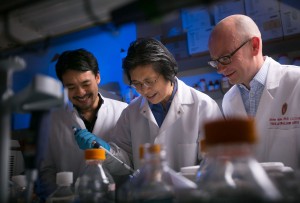UW-Madison scientists have grown human vocal cord tissue in a dish, which made sound when transplanted into voice boxes from cadaver dogs, a development that could lead to better treatments for people with voice disorders. Such implants likely won’t be ready for human testing for years. But re-creating the tissue, known as a vocal fold, and showing it was functional in dog larynges and was not rejected by a mouse model of the human immune system are significant steps, the researchers said. “We never imagined that we would see the impressive level of function that we did and that this engineered tissue, created with actual human vocal fold cells, would have such strong potential as a therapy,” said Nathan Welham, a UW-Madison speech language pathologist and leader of the research team.
About 20 million Americans suffer from voice damage at any given time. Many of the problems go away on their own, but injury, cancer, nerve damage and other conditions can cause permanent harm, Welham said. Voice therapy, injections of collagen or other synthetic materials, and surgery sometimes involving transplants of tissue from inside the patient’s cheek can help, Welham said. But “none of them really are satisfactory,” he said. The scientists faced a formidable task in trying to engineer a replacement tissue for the vocal cord. Such tissue must be soft and pliable enough to create waves of vibration but strong enough to withstand rapid acceleration and stress. “There is no other tissue in the human body that is subject to these types of biomechanical demands,” Welham said.
He and others, including Changying Ling, an associate scientist in Welham’s lab, took healthy vocal cord tissue from a person who had just died and four patients who had their larynges removed for reasons other than cancer. They isolated and purified two types of cells fibroblasts and epithelial cells and grew them in a dish on a 3-D scaffold. In about two weeks, the cells formed tissue that produced many of the same proteins as normal vocal cord cells. “They’re effectively talking to each other and producing the structural proteins that make this special tissue capable of vibration,” said Brian Frey, a UW-Madison associate scientist in chemistry involved in the research. “The biology does most of the work,” Frey said. “We just have to use the correct cells and give them the right environment to do their job.”
To see if the tissue could make sound, the researchers transplanted it onto larynges removed from dead dogs and attached to artificial windpipes. When humidified air blew through the model, the tissue produced sound like a kazoo, similar to what the human voice sounds like before it is modulated by the throat, mouth and nose, Welham said. The engineered tissue performed better than tissue taken from inside the cheek, the researchers said.
To see if the human body would reject such an implant, the scientists placed it in two kinds of mice one engineered to have the larynx cell donor’s immune system and one with other human immune systems. The engineered tissue grew in the mice and was not rejected, though the mouse model was a relatively short-term test. The tissue’s structure was less complex than adult vocal cords, which continue to develop 13 years after birth. A large supply of human vocal cord cells isn’t readily available, so broad use of such implants might have to rely on other sources, such as stem cells, the researchers said. Welham called the proof-of-principle study a “robust benchmark” toward replacement vocal cord tissue, but he said much work remains before human testing can begin. “There are many considerations and milestones that need to be met to bring this to clinical trial,” he said.
For more information please visit: www.wisc.edu

